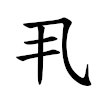Hello, you have come here looking for the meaning of the word
丮. In DICTIOUS you will not only get to know all the dictionary meanings for the word
丮, but we will also tell you about its etymology, its characteristics and you will know how to say
丮 in singular and plural. Everything you need to know about the word
丮 you have here. The definition of the word
丮 will help you to be more precise and correct when speaking or writing your texts. Knowing the definition of
丮, as well as those of other words, enriches your vocabulary and provides you with more and better linguistic resources.
Translingual
| Stroke order
|

|
Han character
丮 (Kangxi radical 2, 丨+3, 4 strokes, cangjie input 弓手 (NQ), four-corner 17510, composition ⿹⺄𰀁)
Derived characters
Descendants
- 丸 (simplification in some characters, such as 孰)
References
- Kangxi Dictionary: page 79, character 6
- Dai Kanwa Jiten: character 74
- Hanyu Da Zidian (first edition): volume 1, page 51, character 7
- Unihan data for U+4E2E
Chinese
Glyph origin
| Historical forms of the character 丮
|
| Shang
|
Western Zhou
|
Shuowen Jiezi (compiled in Han)
|
Liushutong (compiled in Ming)
|
| Oracle bone script
|
Bronze inscriptions
|
Small seal script
|
Transcribed ancient scripts
|

|

|

|

|
 j05354  j05355  j05356  j05357  j05358  j05359  j05360  j05361  j05362  j05363  j05364  j05365  j05366  j05367
 b03725  b03726
 s02137
Transcribed ancient scripts  L28604  L28605 |
References:
Mostly from Richard Sears' Chinese Etymology site (authorisation),
which in turn draws data from various collections of ancient forms of Chinese characters, including:
- Shuowen Jiezi (small seal),
- Jinwen Bian (bronze inscriptions),
- Liushutong (Liushutong characters) and
- Yinxu Jiaguwen Bian (oracle bone script).
|
|
|
Old Chinese
|
| 丮
|
*kraɡ
|
| 谻
|
*kraɡ, *kraɡ
|
Pictogram (象形) — A person kneeling with their hands stretched out, as if they are holding something.
Pronunciation
| Baxter–Sagart system 1.1 (2014)
|
| Character
|
丮
|
| Reading #
|
1/1
|
Modern
Beijing
(Pinyin)
|
jǐ
|
Middle
Chinese
|
‹ kjæk ›
|
Old
Chinese
|
/*rak/
|
| English
|
grasp
|
Notes for Old Chinese notations in the Baxter–Sagart system:
* Parentheses "()" indicate uncertain presence;
* Square brackets "" indicate uncertain identity, e.g. * as coda may in fact be *-t or *-p;
* Angle brackets "<>" indicate infix;
* Hyphen "-" indicates morpheme boundary;
* Period "." indicates syllable boundary.
|
| Zhengzhang system (2003)
|
| Character
|
丮
|
| Reading #
|
1/1
|
| No.
|
5779
|
Phonetic
component
|
丮
|
Rime
group
|
鐸
|
Rime
subdivision
|
0
|
Corresponding
MC rime
|
戟
|
Old
Chinese
|
/*kraɡ/
|
Definitions
丮
- to hold
References
Japanese
Kanji
丮
(Hyōgai kanji)
- to catch, to get
Readings
Korean
Hanja
丮 (eum 극 (geuk))
- catch
Vietnamese
Han character
丮: Hán Nôm readings: kịch
- This term needs a translation to English. Please help out and add a translation, then remove the text
{{rfdef}}.























